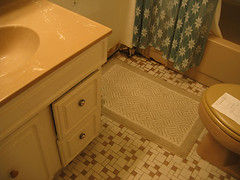 |
| (Photo credit: Rick Scully) |
Make sure to verify with your contractor's insurance company to make sure that they are actually insured. Unscrupulous contractors may try to hoodwink consumers by presenting an expired insurance card when asked for proof of insurance.
The first thing to consider is safety. If you live in an older property it is advisable to have the building assessed by professionals for both asbestos and lead based paints. Often these substances are found in older buildings and while they are fairly safe when left as they are, if they are disturbed during remodeling work they can get dangerous for everyone in the building.
When renovating, a smart homewoner will spend his money on good quality materials and fixtures instead of expensive decor and furniture. There's a simple reason for this--decorative items and furniture get moved out along with the homeowner when the house gets sold. You want to add value to your home, and by buying durable products that remain there, you do that.
Stained wood is more aesthetically pleasing than painted whenever you're replacing baseboards. The classic look of finished wood complements virtually any home decor style. Stained backboards also serve the benefit of defending against stains and marks, which can increase its longevity. There are many colors of stain to match your decor.
Things like painting or adding a deck to your home can improve your home's quality by a lot. Decks could give you a great place to entertain your guests and you could use it in a hot summer day to relax.
Check the credentials of any professional you employ for any home improvement projects. You must be sure that they have the qualifications to do the job correctly and that the job will be completed using the highest possible standards. The easiest way to verify a contractor's bona fides is by checking his credentials with the relevant licensing authority.
Making sure that your gutters are clean is a great way to improve your home. When your gutters are clogged with debris, the water is trapped and can cause leaks. This may end up causing the wood to rot. It is important to maintain clean gutters at all times!
Adding an extra bathroom can really increase the value of your home. It is easy to understand that an additional bathroom is handy, particularly when each bathroom is on a different floor of the home. It is very likely that multiple household members will need access to the bathroom simultaneously. You must ensure the bathroom is properly installed to avoid leaks which can lead to water damage and mold.
Always keep safety at the front of your mind. While it may seem silly to wear a hardhat in your own home, if a chunk of drywall were to fall, you would at least be protected. Having hardhats, goggles, and breathing apparatus can help to keep you healthy while you take care of your home.












